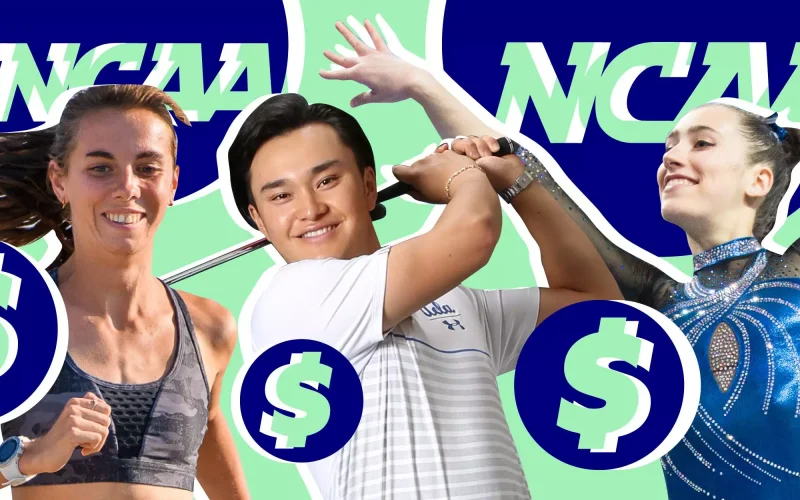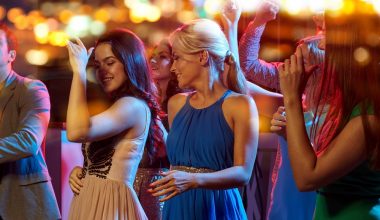A significant change is occurring in college sports due to this one important question: Should college athletes be compensated? In response, the NCAA introduced an interim name, image, and likeness (NIL) regulation in June 2021 that permits student-athletes to earn revenue from their brands.
Though this law does not work for very state, you might not be required to abide by certain NIL rules in your state. The guidelines established by the high school sports association in your state will determine whether or not high school students can participate in NIL events. Universities and colleges have their own special NIL regulations.
The U.S. Supreme Court decision regarding Name, Image, and Likeness NCAA(NIL) is the most recent illustration of how, recruiting environment is changing. It might be hard to comprehend this landmark decision, which has opened up new world of opportunity for NCAA players.
We can explain everything you need to know about Name Image Likeness NCAA, whether you are an athlete, a high school student or college coach.
Table of Contents
- Overview of Name, Image, and Likeness History
- What Exactly is NIL NCAA?
- What is Name Image Likeness NCAA Collective?
- What is the Importance of Name Image Likeness
- How Does This Affect Me Personally?
- NCAA’s Current Rules on NIL
- Name, Image Likeness Top Earners
- Name, Image and Likeness NCAA Examples
- Name, Image, Likeness NCAA Opportunities
- Name Image Likeness NCAA Pros and Cons
- FAQs on Name Image Likeness NCAA
- Conclusion
- References
- Editor’s Recommended Posts
Overview of Name, Image, and Likeness History
Knowing the events and rulings that led to the situation where college athletes now have the right to their NIL is very useful.
Former UCLA basketball player Ed O’Bannon sued NCAA and the Collegiate Licensing Company in July 2009.
O’Bannon alleges that these businesses broke antitrust laws by exploiting his NIL without his consent in the NCAA Basketball 09 video game by EA Sports. He is asking for an order that would allow players to be paid for their NIL.
The twenty former athletes join O’Bannon as plaintiffs in the lawsuit between 2009 and 2014.
District Judge Claudia Wilken of California made a favourable decision for O’Bannon and the other competitors in August 2014.
She concluded that the NCAA regulations banning athletes from making money off their NIL will break antitrust laws.
When Governor Gavin Newsom signs “The Fair Pay to Play Act,” allowing athletes of any age to generate money from NIL, California becomes the first state to implement legislation on NIL. In the following months and years, more states follow suit.
The NCAA started to develop and finalize federal law relating to NIL rights in December 2019.
June 2021 — In a unanimous decision, the U.S. Supreme Court rules against the NCAA and that NCAA limits on NIL activities are illegal under antitrust laws.
Days later, the NCAA temporarily relaxed its regulations and permitted NIL participation, directing individual universities to develop their student-athlete policies.
The NCAA modified there policies permanently in July 2021 and now permits athletes to make money off their NIL. Athletes start establishing endorsement deals and securing sponsors.
What Exactly is NIL NCAA?
Its literal meaning is name image likeness in NCAA, and it alludes to the capacity of college athletes to make money off of themselves.
NIL grants athletes the right to the publicity that regular people already have but that the NCAA had previously prohibited.
Players can promote themselves or other businesses in public appearances or take payment in exchange for featuring them in products or commercials.
College football players, like all other student-athletes, were previously prohibited from selling their likenesses while receiving financial aid. The new NIL regulation modifications entirely overturn that precedent.
What is Name Image Likeness NCAA Collective?
A collective is a business that gathers financial resources and gives them to athletes in exchange for the right to use their name, image, and likeness.
Wealthy Alumni found collectives when they were attending a university.
They’re not run by colleges, or their athletic departments, collectives assist in NIL deals for athletes.
The NCAA is tightening its enforcement of the ban on booster involvement in recruitment to cover any potential NIL violations boosters utilizing collectives to entice recruits to their schools with the promise of lucrative NIL deals.
Read Related Post: What are Credit Hours in College? How Does it Work?
What is the Importance of Name Image Likeness
The NCAA and other collegiate athletic groups have long backed amateurism, as participating in sports without receiving payment.
The NIL decision complicates what it means to be an amateur. Collegiate athlete because these people can now make money from their NIL without competing at the professional level.
This decision has affected recruiting because athletes may now consider NIL endorsements when choosing which colleges to attend.
It is important to remember that NIL deals are not a recruiting perk, and no player can expect any deal during the recruiting process.
How Does This Affect Me Personally?
Athletes in high school and their parents:
Despite the U.S. Supreme Court ruling, high school athletes in 49 states do not own their NIL.
The National Federation of State High School Associations (NFHS) has made it clear that current high school student-athletes are not permitted to receive compensation for participating on a team at their school.
But in California, “The Fair Pay to Play Act” allows high school players to make money off their NIL, subject to a few restrictions.
So, if you are a high school athlete in California, you might be able to make money off of your NIL.
No matter where you live, there are two things you should do if you plan to play sports in college. You must first be aware of your online presence.
Building a reputable online profile that marketers will value requires being mindful of what you publish, who you follow, which photographs you like, and the language you use.
Along with your internet presence, choosing a college is a big decision that involves much more than the chance NIL offers.
Even if they are alluring, base your choice to attend a particular school only on the possibility of getting sponsorship or endorsement.
When recruiting:Iit is important to keep your eye on the prize: you want to compete at the highest level possible in sports, not score no-deal contracts.
This doesn’t exclude you from asking college coaches questions regarding NIL during the recruitment process; it only means that none of their responses should have a decisive impact on your decision.
Also Read: How Long Are College Soccer Games? All You Need to Know
Club Coaches and High School Teachers:
Many inquiries about your athlete NIL rights will surface as they start their recruiting processes. By supplying your athletes with informational materials about NIL rights, you may help them understand this novel and perplexing environment.
The best method is to educate them to ensure they are knowledgeable of the recruitment process and aware of the repercussions of NIL when they begin their college careers as student-athletes.
NIL should be broken out in any curriculum, and the new law should be explained to athletes once they enter college.
It should go through the financial repercussions of signing NIL contracts and advise athletes on what questions to ask college coaches while recruiting.
One More Point
Never base your college choice solely on earning a sponsorship or endorsement. This a simple truth that education around NIL should continually reinforce.
NCAA Coaches
As an NCAA Coach, you are in a special position in the new NIL age because you must communicate with recruits and your athletes while navigating it.
Recruits will likely have inquiries regarding NIL and the opportunities available at your institution. It’s crucial to rely only on what you can be certain of and to keep quiet on the once you do not know about.
You will learn to provide them with as much information as possible without breaching regulations.
This new rule offers your athletes tremendous opportunities, but it may also force them to make difficult choices that feel overwhelming.
Teaching your athletes the fundamentals of NIL rights, how to manage and leverage their brand, in communication, and money management skills will help them take advantage of the opportunities presented to them.
Reiterate the rules about what athletes can and cannot discuss in public settings, such as radio interviews, TV ads, podcasts, etc.
More than anything, communication with your athletes is vital. Talk to them, let them ask questions and voice concerns, and know when to consult a professional.
Additionally, if your athletes are receiving NIL deals, be sure to support them in whatever way possible, but do so for all of your athletes who sign an agreement.
NCAA’s Current Rules on NIL
Student-athletes prohibited from receiving compensation for athletic-related tasks like endorsements and autograph signings by current NCAA rules.
NCAA President Mark Emmert has defended the idea that “college athletics is about college students playing other college students, not employees playing employees,” citing the Association’s long-standing concept of amateurism.
The three divisions now have different rules on how student-athletes can use their NIL under NCAA rules.
Athletics compliance professionals spend considerable time teaching student-athletes the “do’s” and “don’t” of the rules despite the complexity of the current standards.
Also See: 22 Best Rocky Mountain Colleges In The USA | 2024
The Name Image Likeness NCAA Claims That:
Division I student-athletes are not allowed to support or promote a commercial good or service to maintain their NCAA eligibility, even if they’re not getting paid to participate in the activity.
However, some exceptions pertain to a student-athlete’s NIL, most frequently in media activities, national governing body promotions, charitable, educational, and nonprofit promotions, camp and congrats marketing.
Also, according to the NCAA, “Since 2015, over 98% of waivers submitted to allow student-athletes to use their name, image, or likeness to promote a non-athletically related business or product have been approved.”
Name Image Likeness NCAA in The Business Space
There have been a few instances of student-athletes gaining waivers in the business world. For instance, competitive swimmers can use a product designed, produced, and marketed by Princeton swimmer Matthew Marquardt and his brother as a footing for backstroke starts.
Another illustration is Katarina Samardzija, a former Grand Valley State University tennis player who founded her own company and designed the Wrist Locker, a wrist wallet for carrying valuables while exercising.
Name, Image Likeness Top Earners
Bronny James, a student at Sierra Canyon High School
A young basketball player with potential who shares a name with one of the three best players in the sport’s history will garner a lot of attention.
With NBA legend Chris Paul serving as his godfather and LeBron James as his father, Bronny James has big shoes to fill.
The 18-year-old has reportedly already received offers from some of the nation’s most popular universities, including the University of Kentucky, the University of Michigan, and Ohio State University. Most experts believe he will play once he graduates from high school.
Given his household recognition, developing potential, and enormous social media impact, On3 NIL has valued Bronny James at $7.6 million.
Arch Manning, a Texas University Student
Arch Manning, a star athlete whose last name is synonymous with football, is the grandson of former New Orleans Saints quarterback Archie Manning and the nephew of brothers Eli and Peyton Manning, who have won multiple Super Bowls. He thus has the pedigree necessary for a lengthy and fruitful college and professional career.
The top recruit in the 2023 class, Arch Manning has a NIL valuation of $3.7 million and committed to the University of Texas, one of the most influential and pro-active institutions for helping to promote and foster the student-athlete’s NIL potential.
Read Also: 50 Best Sports Games Unblocked For College And Highschool Students
University of Memphis student Mikey Williams
Mikey Williams has lost no time in capitalizing on his reputation after signing a game-changing sponsorship agreement with the sportswear company Puma. He is the first high school basketball player in America to do so.
Williams, a four-star prospect in the 2024 class, has committed to play for the University of Memphis under NBA great Penny Hardaway. On3 NIL has valued Williams at $3.6 million.
University of Southern California’s Caleb Williams
Caleb Williams, who has already won the Heisman Trophy and the Maxwell Award, is on the rise in college football and seems headed for the NFL Draft in the future.
Williams’ worth according to On3 NIL is $3.2 million, and the quarterback has already signed contracts with companies including AT&T, Athletic Brewing Company, and Fanatics.
Louisiana State University Student Olivia Dunne
Olivia Dunne is one of the most marketable college athletes in the nation and is arguably the most well-known name in college athletics since the NIL policy was implemented. She has agreements with companies like ESPN, Grubhub, Forever 21, and many other worldwide organizations.
According to reports, Dunne made over $1 million in her first year of operation. On3 NIL predicts that her deal-making prowess will triple this year, and a $3.2 million value will catapult her into the top 5. Learn More.
Name, Image and Likeness NCAA Examples
The NCAA applies (and enforces) these NIL regulations across various usage scenarios. Let’s look at two examples to demonstrate both present and historical use.
The first storyline concerns Enes Kanter, a prospective Kentucky basketball player, and the second concerns the scandal involving the “Fab Five” from Michigan.
Although the former emphasizes in many ways why so many support student athletes’ rights to remuneration, the latter highlights the NCAA’s biggest concerns should its rules and regulations be abandoned or completely disregarded.
See More: 15+ Best Outdoor Education Colleges 2024
Kentucky’s Enes Kanter
Enes Kanter, a freshman center for Kentucky, was declared permanently ineligible to participate in college sports in 2011 by the NCAA after being found to have received $33,000 in “impermissible benefits” from a professional Turkish club team a few years earlier.
The school tried to challenge the decision, but the NCAA persisted. The NCAA Vice President of Academic and Membership Affairs said at the time, even though the decision caused disappointment in many:
Since he received a sizeable sum of money from a professional team before enrolling in college, in addition to his actual expenses, the reinstatement committee’s final decision is fully consistent with the collegiate sports model our members have built.
Even though Kanter could not compete in college sports, the Utah Jazz selected him in the first draft round that year. He has also played for the Boston Celtics, Portland Trail Blazers, New York Knicks, and Oklahoma City Thunder.
Ed Martin and the “Fab Five” controversy in Michigan
Jimmy King, Juwan Howard, Chris Webber, Jalen Rose, and Ray Jackson were regarded as an unequaled feat in collegiate sports recruiting upon their arrival in Ann Arbor, Michigan, in 1991, and they lived up to that expectation.
They never won a championship, but their two back-to-back visits in the national championship game in 1992 and 1993 thrilled the collegiate basketball world. Read more here
Name, Image, Likeness NCAA Opportunities
FOOTBALL DIRECTOR NAME, IMAGE, AND LIKENESS
Seattle, Washington – University of Washington
Job Specifics
Monthly range: $5,457 to $6,667
Qualifications
Legal education for three years
Master’s Degree
Bachelor’s degree in sports Marketing
Organizing Abilities
Skills in leadership and Communication
For job details visit Website
Sales Coordinator for Name, Image, and Likeness (NIL)
Excel Sports Management – 5.0 Los Angeles, California
Job details
$64,500 – $67,500 a year
Qualifications
Affinity Photo
Microsoft Excel Analysis
Microsoft Office Marketing for Sports
Under one year Bachelor’s degree Adobe Acrobat Marketing
For more details
Name Image Likeness NCAA Pros and Cons
Name, image, and likeness rights for college athletes were codified in NCAA rules and some state legislation on June 21, 2021. Therefore, as long as they maintain their amateur athlete status and eligibility for NCAA competitions, players can make money through product sponsorships, social media deals, promotional activities, appearances, autograph sessions, camps, and clinics.
There are still numerous issues with the decision, despite the fact that many people view it as a step in the right way toward sportsmen receiving their rightful recompense. Make sure you are aware of the benefits and drawbacks of doing so if you are a college athlete trying to capitalize on your NIL.
See More: How to Search for a Grad School | Best College Board in 2024
Cons of NIL
Some athletes may shift their priorities from academics to attending a school where the NIL market is growing, prioritising making money more than receiving a decent education.
High school students may also begin to choose big-time athletic departments that can maximize NIL endorsements over smaller institutions where they can participate in more sports and perhaps find a better academic fit.
NIL can lead to player imbalances where some players are more likely than others to land deals. NIL also brought about inequalities between sports, with individuals in more lucrative sports potentially having greater possibilities.
Male athletes have more chances and a greater potential for financial reward than female athletes.
Black female collegiate athletes may have the fewest employment prospects overall, adding to the financial constraints already faced by underrepresented populations.
Pros of NIL
NIL offers support for individuals who depend on financial aid (or walk-ons and D3 athletes who aren’t awarded scholarships).
NIL can help people who have to pay for their own education feel less emotionally stressed
With a large following on platforms like Instagram, Twitter, and TikTok, athletes can make money from commercial endorsements.
Before graduating, college athletes can develop a larger network of contacts to develop their brands and gain expertise in the field.
Although there is still disparity, NIL can help under-the-radar sports and players become more well-known.
FAQs on Name Image Likeness NCAA
A person’s “right of publicity”—their capacity to profit from everything that identifies them—is known as Name, Image, and Likeness. This includes their capacity to accept sponsorships and endorsements from outside parties.
The typical income from NIL deals for student-athletes is often between $1,000 and $10,000, however there have been situations where athletes have made much more than that.
Name, Likeness, and Image
An “NIL,” for Name, Image, and Likeness, refers to how college athletes may be compensated. A brand would be “using” an athlete’s NIL if it used their name, likeness, and/or reputation in marketing or promotional activities.
Athletes, famous people, and influencers can decide how their likeness, name, and image are utilized for commercial purposes.
A person or business may be subject to legal action if it makes an unlawful or improper attempt to leverage their own brand for its own financial gain.
Conclusion
When deciding whether or not to participate in NIL NCAA events, there is no right or wrong answer. Just make sure you’re well-informed and taking responsibility for your own choices.
References
- recruiting.fieldlevel.com ______ Breaking Down Name, Image, and Likeness
- biz.opendorse.com ______ What is Name, Image and Likeness (NIL)?
- 2adays.com ________ Pros and Cons of NIL





